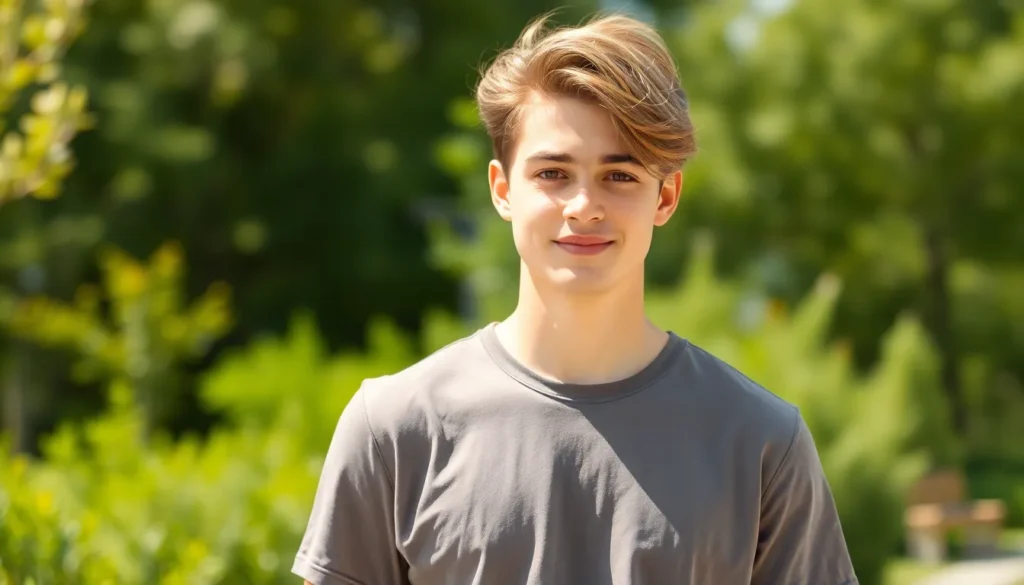Flow hairstyles have taken the industry by storm, transforming how we think about modern men’s grooming. This effortlessly cool look combines length with movement, creating that perfect “just rolled out of bed but still look amazing” vibe that’s captivated everyone from athletes to actors.
We’ve watched flow hairstyles evolve from hockey rinks to red carpets, becoming one of today’s most sought-after trends. The beauty lies in its versatility – whether you’re going for a subtle wave or dramatic length, flow styles work with virtually any hair type and face shape.
What makes flow hairstyles truly special is their low-maintenance appeal combined with high-impact results. You don’t need hours of styling or expensive products to achieve that coveted flowing look. We’ll show you everything from choosing the right cut to mastering the styling techniques that’ll have you rocking perfect flow in no time.
What Are Flow Hairstyles and Why Are They Trending
Flow hairstyles represent a distinctive men’s grooming approach that emphasizes natural movement and texture through strategically layered cuts. These cuts typically feature longer lengths on top that gradually blend into shorter sides, creating a cascading effect that mimics natural hair movement. Professional stylists define flow cuts as medium to long hairstyles that maintain shape while allowing hair to move freely with natural body motion.
Key characteristics include:
- Length variation ranging from 4 to 8 inches on top with tapered sides
- Layered texturing that creates depth and dimensional movement
- Natural parting that follows individual hair growth patterns
- Versatile styling options from tousled to sleek finishes
Social media platforms have propelled flow hairstyles into mainstream popularity, with hashtags like #flowhair generating millions of views across Instagram and TikTok. Celebrity endorsements from athletes like tennis player Stefanos Tsitsipas and actors such as Timothée Chalamet have amplified the trend’s visibility among younger demographics. Professional barbers report a 40% increase in flow cut requests since 2022, according to industry surveys from leading grooming publications.
Trending factors driving popularity:
- Remote work flexibility allowing longer hairstyles in professional settings
- Athletic influence from hockey players and surfers showcasing natural flow styles
- Gender fluid fashion embracing longer hair as a masculine style choice
- Low maintenance appeal requiring minimal daily styling compared to structured cuts
Modern flow hairstyles adapt to various hair textures, from straight European hair to wavy Mediterranean types and curly African American textures. Stylists customize cutting techniques based on individual hair characteristics, ensuring each flow cut complements natural growth patterns and face shapes. This personalized approach explains why flow styles work across diverse demographics and age groups.
The trend’s staying power stems from its ability to bridge casual and formal styling needs without requiring extensive product investment or daily manipulation. We’ve observed flow hairstyles transitioning seamlessly from beach settings to business casual environments, making them particularly appealing to men seeking versatile grooming answers.
Classic Flow Hairstyles That Never Go Out of Style
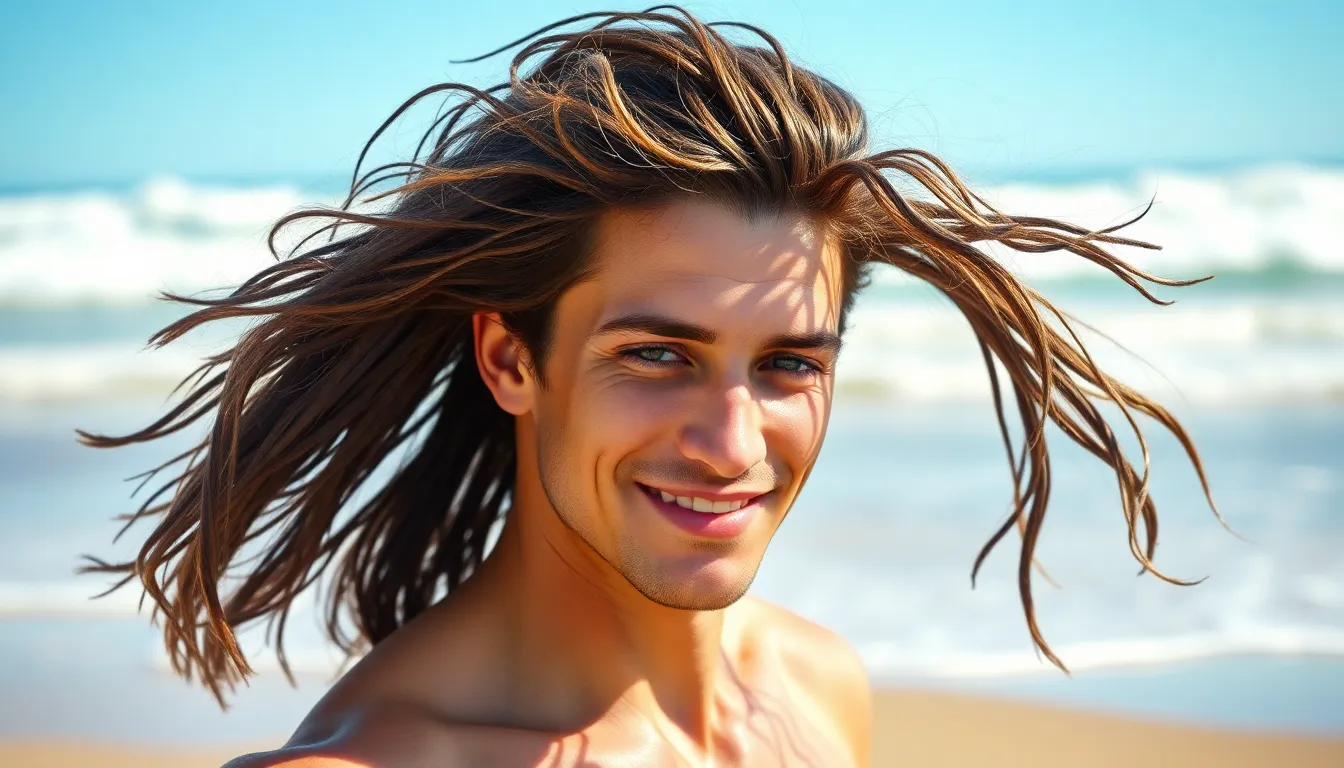
These timeless flow variations have maintained their popularity across decades, proving that certain styles transcend temporary trends. Each classic cut offers distinct characteristics that continue to attract men seeking effortless style with lasting appeal.
The Traditional Hockey Flow
Hockey flow delivers the quintessential long hair look that originated on ice rinks and dominated locker rooms throughout the 1970s and 1980s. This iconic style features hair lengths ranging from 6 to 10 inches, creating natural movement that flows backward from the face. Players like Wayne Gretzky and modern stars such as Erik Karlsson have showcased this cut’s enduring appeal both on and off the ice.
We see hockey flow working best with straight to slightly wavy hair textures, though skilled barbers can adapt the cut for various hair types. The style requires minimal layering around the crown while maintaining substantial length through the back and sides. Most men can achieve this look by growing their hair for 8 to 12 months, depending on their natural growth rate.
Styling hockey flow involves simple techniques that emphasize the hair’s natural direction and texture. Air drying after washing creates the most authentic appearance, while a light texturizing spray can enhance volume and movement. The cut’s low maintenance nature makes it perfect for active lifestyles, requiring only occasional trims every 6 to 8 weeks to maintain shape.
The Surfer Flow
Surfer flow captures the sun kissed, windswept aesthetic associated with beach culture and coastal living. This variation typically features more pronounced layering than hockey flow, with lengths averaging 4 to 7 inches that create natural texture and movement. Professional surfers like Kelly Slater and John John Florence have popularized this effortless style that translates seamlessly from beach to boardroom.
The cut incorporates strategic layering throughout the crown and sides, allowing hair to fall naturally while maintaining body and shape. We recommend this style for men with wavy to curly hair textures, as the natural curl pattern enhances the desired tousled appearance. Straight haired individuals can achieve similar results through proper cutting techniques and styling products.
Salt spray and texturizing mousses work exceptionally well with surfer flow, recreating that ocean air effect. Scrunching damp hair with these products and allowing it to air dry produces the signature beachy texture. The style requires minimal heat styling, making it ideal for men who prefer low maintenance routines while still achieving a polished appearance.
The Rockstar Flow
Rockstar flow embodies the rebellious spirit of music legends while maintaining sophisticated appeal for modern men. This dramatic variation features the longest lengths among flow styles, often reaching 8 to 12 inches with heavy layering that creates volume and movement. Icons like Mick Jagger, Steven Tyler, and contemporary artists such as Harry Styles have demonstrated this cut’s versatility across different eras and music genres.
The style demands precise layering techniques that prevent the hair from appearing heavy or shapeless even though its substantial length. We observe that rockstar flow works particularly well with fine to medium hair textures, as the layering adds necessary body and dimension. Men with thicker hair may require additional thinning to achieve the desired flowing effect.
Professional styling products become more important with rockstar flow due to its length and complexity. Volumizing mousses applied to damp hair before blow drying can enhance the cut’s natural movement, while finishing oils add shine and reduce frizz. The style requires more frequent maintenance than shorter flow variations, with trim appointments recommended every 4 to 6 weeks to preserve the layered structure.
Modern Flow Hairstyles for Today’s Fashion-Forward Look
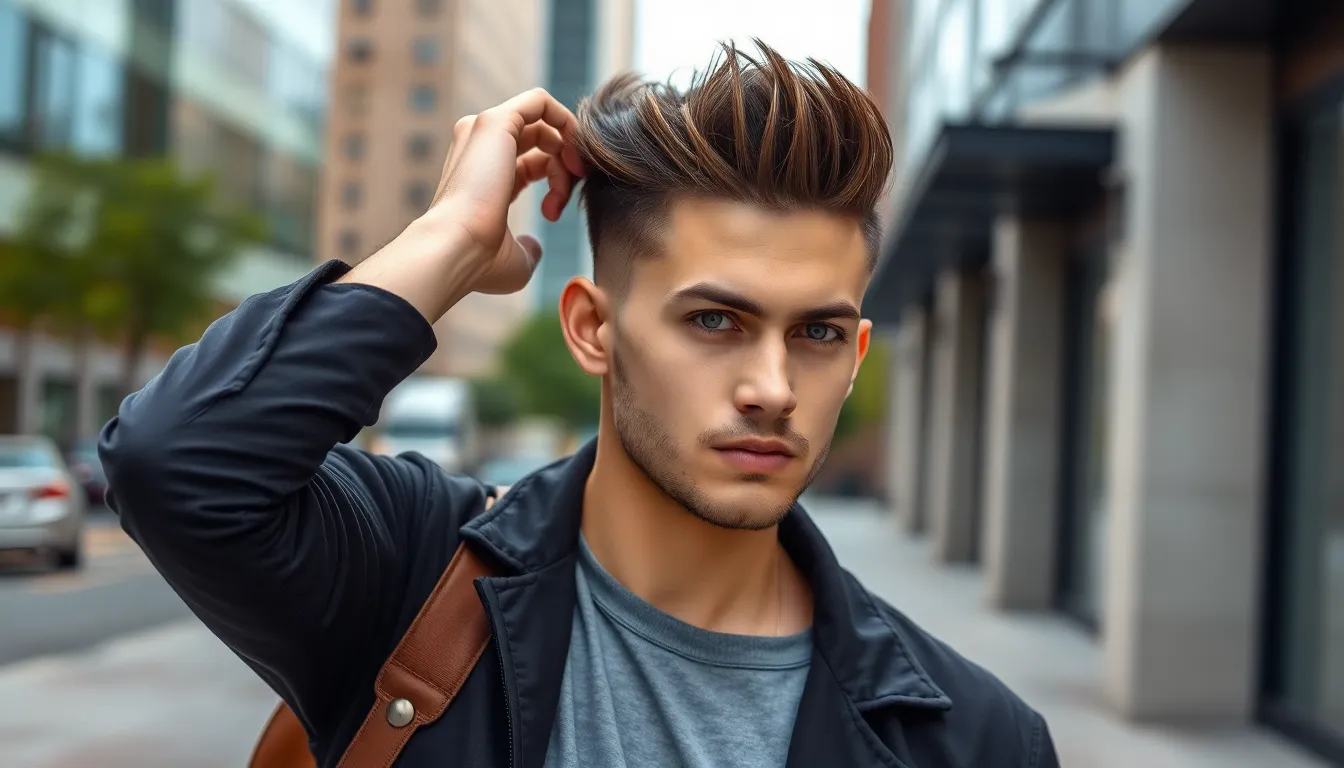
Today’s flow hairstyles embrace contemporary styling techniques that enhance natural movement while maintaining professional versatility. We’ve identified three standout variations that define modern flow aesthetics.
The Textured Flow Cut
Textured flow cuts maximize natural hair movement through strategic layering and point cutting techniques. Stylists create depth by cutting into the hair at various angles, producing a lived-in appearance that works effortlessly with your natural growth patterns. This technique adds dimension to lengths between 5 to 7 inches on top, allowing individual strands to fall naturally rather than forming rigid lines.
Key benefits include reduced styling time and enhanced volume for fine to medium hair textures. The textured approach works particularly well for men with cowlicks or uneven growth patterns, as the varied lengths camouflage these natural irregularities. Maintenance requires trimming every 6 to 8 weeks to preserve the intentionally uneven edge work.
Styling versatility ranges from tousled casual looks using sea salt spray to more polished presentations with light texturizing cream. The cut’s foundation allows for air drying without sacrificing style, making it ideal for active lifestyles and time-conscious professionals.
The Undercut Flow
Undercut flow combinations merge classic barbering precision with flowing top sections, creating distinct contrast between trimmed sides and longer crown areas. The sides typically measure 0.5 to 2 inches in length, while the top maintains 6 to 9 inches for optimal flow movement. This dramatic length difference emphasizes the flowing sections and adds structural definition to face shapes.
Modern variations include subtle skin fades that gradually blend into the longer sections, creating seamless transitions rather than harsh lines. Barbers often incorporate temple fades or neckline tapering to soften the overall appearance while maintaining the style’s bold character. The contrast works exceptionally well for thick, coarse hair that can support the weight of longer top sections.
Professional adaptability makes this style workplace-friendly when styled conservatively, yet edgy enough for evening social settings. The defined sides provide structure for formal occasions, while the flowing top offers casual versatility for weekend activities and creative environments.
The Fade Flow
Fade flow styles represent the most technical modern variation, incorporating graduated length transitions from ultra-short sides to flowing top sections. Skilled barbers create seamless blends using multiple clipper guard sizes, typically starting with a 0 or 1 guard at the hairline and gradually increasing to 3 or 4 guards at the transition point. The top section maintains 5 to 8 inches to achieve proper flow dynamics.
Technical execution requires precise clipper work and careful attention to head shape contours. High fades begin the transition above the temples, mid fades start at temple level, and low fades begin just above the ears. Each variation creates different visual proportions and complements exact face shapes differently.
Contemporary appeal stems from the style’s Instagram-ready appearance and celebrity endorsements from athletes and entertainers. The crisp fade work provides a fresh, clean foundation that makes the flowing sections appear more intentional and styled. Maintenance demands professional touch-ups every 3 to 4 weeks to preserve the fade’s precision, though the flowing sections remain flexible between appointments.
How to Achieve the Perfect Flow Hairstyle at Home
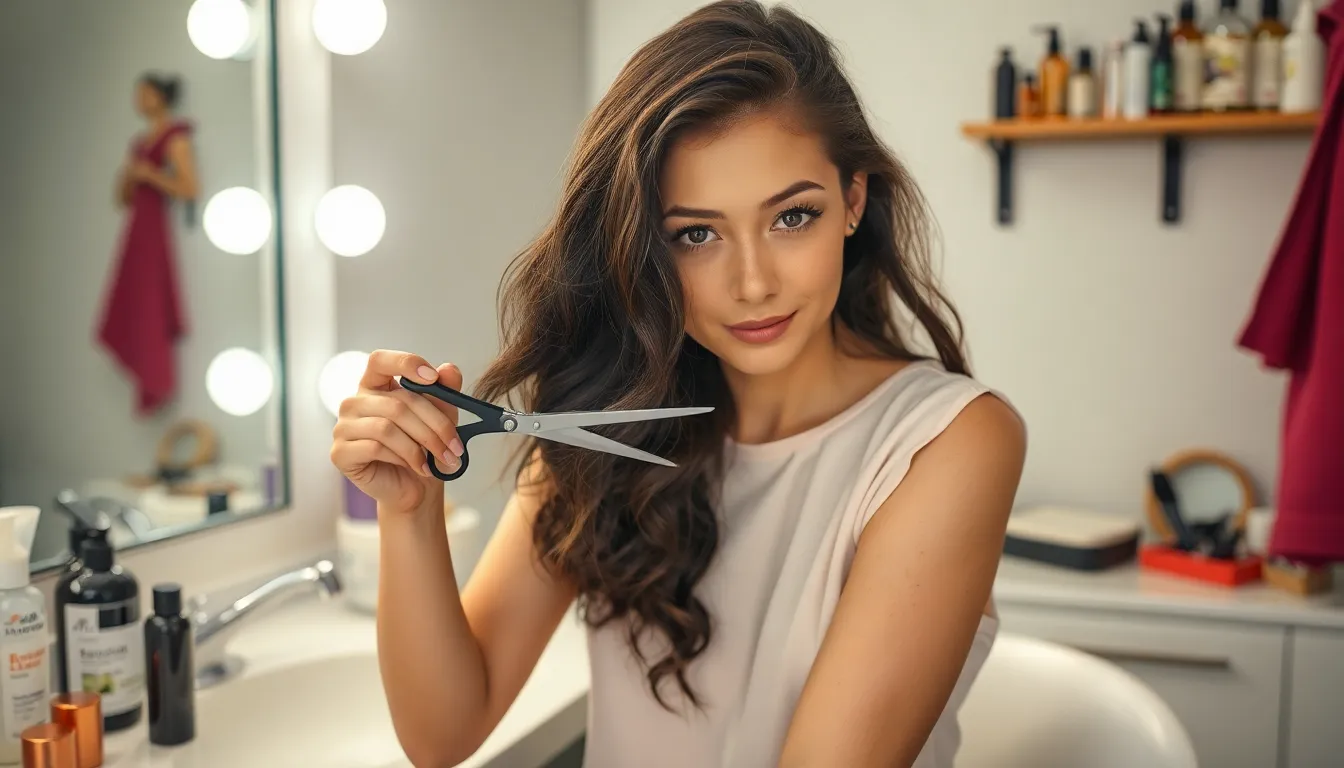
Creating a salon-quality flow hairstyle in your own space requires the right approach and techniques. We’ll guide you through the essential tools, proven methods, and critical pitfalls to avoid for achieving that effortless, textured look at home.
Essential Tools and Products You’ll Need
Quality hair clippers form the foundation of any successful flow cut, with adjustable guards ranging from 1 to 8 for precise length control. We recommend investing in ceramic or titanium blade clippers that maintain sharpness and reduce heat buildup during extended styling sessions.
Texturizing shears create the layered movement that defines flow hairstyles, allowing you to remove bulk while maintaining natural texture. Professional-grade thinning scissors with 30 to 40 teeth work best for achieving that signature feathered appearance without creating harsh lines.
Sea salt spray enhances natural waves and adds grip to fine hair, making it easier to achieve volume and texture. We suggest choosing alcohol-free formulas that won’t dry out your hair while providing lasting hold and definition.
Lightweight styling cream offers flexible hold without weighing down longer sections, perfect for maintaining flow movement throughout the day. Products containing natural oils like argan or jojoba provide nourishment while keeping hair manageable and soft.
Wide-tooth comb prevents breakage when detangling wet hair and helps distribute products evenly from roots to ends. Metal or carbon fiber options resist static buildup and provide smoother gliding through textured sections.
Blow dryer with diffuser attachment controls frizz in wavy or curly hair types while maintaining natural texture patterns. We recommend ceramic or tourmaline dryers that emit negative ions for reduced damage and enhanced shine.
Step-by-Step Styling Techniques
Start with clean, towel-dried hair that retains about 70% moisture for optimal product absorption and styling control. We apply a small amount of heat protectant spray before any thermal styling to prevent damage and maintain hair health.
Section your hair horizontally from ear to ear, creating distinct zones for systematic cutting and styling. Work from the bottom layer upward, ensuring each section blends seamlessly with the previous one for consistent length graduation.
Cut the back and sides first using a #3 or #4 guard, gradually increasing length as you move toward the crown area. We recommend using an upward flicking motion with the clippers to create soft transitions rather than harsh lines.
Layer the top section using point cutting techniques, holding small sections vertically and cutting into the hair at varying angles. This creates the textured, uneven edges that give flow hairstyles their characteristic movement and body.
Apply styling products to damp hair, starting with sea salt spray at the roots and working lightweight cream through mid-lengths to ends. We use scrunching motions to enhance natural texture while avoiding over-manipulation that can cause frizz.
Diffuse or air dry depending on your hair type, using low heat settings and intermittent airflow to preserve curl patterns. For straight hair, we recommend rough-drying with fingers to create volume and natural-looking texture.
Common Mistakes to Avoid
Cutting too much length initially represents the most frequent error when attempting flow hairstyles at home. We always recommend starting longer and gradually removing length, as you can’t add hair back once it’s cut too short.
Using too much product weighs down the hair and eliminates the natural movement that defines flow styles. Start with a dime-sized amount of cream or 2-3 sprays of sea salt spray, adding more only if necessary for hold or texture.
Neglecting regular maintenance leads to overgrown, shapeless results that lose the structured flow aesthetic. We suggest trimming every 6-8 weeks to maintain proper proportions and prevent split ends from traveling up the hair shaft.
Attempting complex layering techniques without proper experience often results in uneven, choppy cuts that require professional correction. Focus on basic texturizing methods and leave intricate layer work to experienced stylists for best results.
Ignoring your natural hair texture creates unrealistic expectations and styling frustration when trying to achieve looks unsuited to your hair type. We recommend working with your natural patterns rather than fighting against them for more successful outcomes.
Skipping heat protection during blow drying or styling tool use leads to cumulative damage that makes hair brittle and difficult to style over time. Always apply thermal protection products before using any heated styling tools.
Best Flow Hairstyles for Different Hair Types

Different hair textures require exact flow approaches to maximize their natural movement and styling potential. We’ve identified the most effective flow variations that work with your hair’s unique characteristics rather than against them.
Flow Styles for Straight Hair
Classic Side Swept Flow works exceptionally well for straight hair textures because it creates natural movement without fighting your hair’s natural direction. We recommend keeping the top length between 5 to 7 inches while maintaining subtle layers throughout. Texturizing spray adds grip and prevents the sleek appearance from looking too flat against your scalp.
Pompadour Flow elevates straight hair by combining volume at the crown with flowing sides that cascade naturally. This style requires medium hold pomade to create lift while allowing the ends to move freely. Straight hair holds this shape remarkably well throughout the day without frequent touch ups.
Curtain Flow divides straight hair down the center, creating symmetrical movement on both sides that frames your face perfectly. We suggest using a lightweight mousse before blow drying to enhance the natural swing. This particular style works best on hair that measures 4 to 6 inches in length across the top section.
Flow Styles for Wavy Hair
Beach Wave Flow maximizes your hair’s natural texture by improving existing wave patterns with strategic layering techniques. We apply sea salt spray to damp hair and scrunch gently to define the waves without creating frizz. This effortless style requires minimal daily maintenance while delivering maximum visual impact.
Tousled Flow embraces the irregular movement that wavy hair naturally provides, creating an intentionally messy yet polished appearance. Texturizing cream worked through slightly damp hair helps separate individual waves while maintaining overall cohesion. We find this style particularly flattering on men with medium to thick hair density.
Brushed Back Wave Flow smooths wavy texture into a sophisticated backward sweep that maintains subtle movement throughout. A boar bristle brush distributes natural oils while creating gentle waves that flow in the same direction. This professional looking style transitions seamlessly from casual to formal settings.
Flow Styles for Curly Hair
Defined Curl Flow celebrates your natural curl pattern while creating controlled movement through strategic cutting techniques. We use curl improving cream on wet hair to define individual curls without weighing them down. Regular trims every 6 to 8 weeks prevent the triangular shape that commonly affects longer curly styles.
Loose Curl Flow relaxes tight curl patterns slightly to create flowing movement while preserving texture and volume. A diffuser attachment on low heat settings helps maintain curl integrity during the drying process. We recommend sleeping on silk pillowcases to reduce friction that can disrupt the curl formation overnight.
Controlled Fro Flow shapes naturally voluminous curly hair into a structured yet free flowing silhouette that commands attention. Leave in conditioner keeps curls hydrated and prevents excessive shrinkage that can limit movement. This bold style works particularly well on men with dense curl patterns who want to showcase their natural texture.
Flow Hairstyles by Face Shape: Finding Your Perfect Match
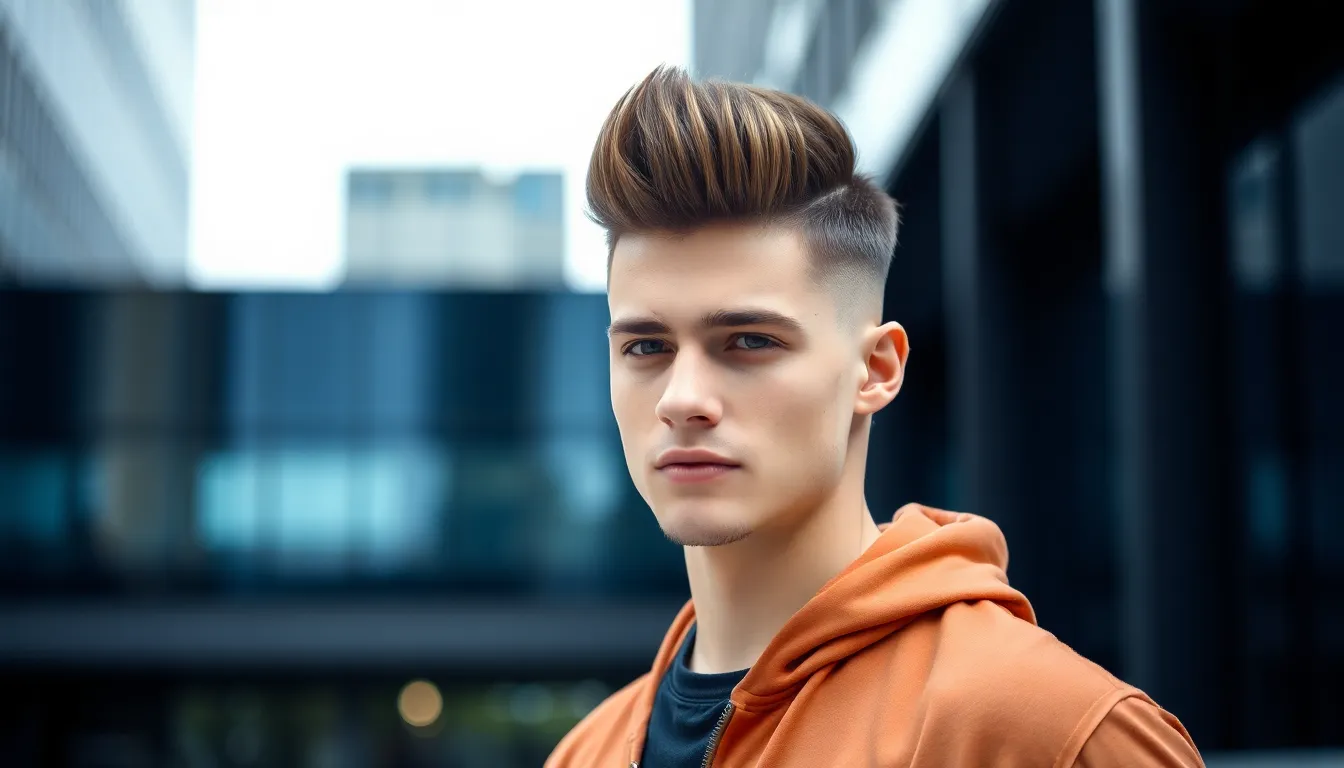
Your face shape determines which flow variation will enhance your natural features and create the most flattering look. We’ll guide you through the best flow options for each face shape to ensure you achieve optimal results.
Best Flows for Round Faces
Angular flow styles work best for round faces by creating vertical lines that elongate your appearance. The Pompadour Flow adds important height on top while keeping sides shorter, which visually stretches your face and creates a more balanced proportion. This style requires 5 to 7 inches of length on top with a gradual fade on the sides.
Textured flow cuts with strategic layering also complement round faces by adding definition and structure. We recommend the Brushed Back Flow which pulls hair away from your face and creates clean lines that minimize width. The key lies in avoiding excessive volume on the sides while maintaining length and movement on top.
Side swept variations like the Classic Side Swept Flow create diagonal lines across your forehead that break up roundness effectively. This approach works particularly well when combined with a subtle undercut that reduces bulk around your ears and temples.
Ideal Flows for Square Faces
Softening techniques become essential for square face shapes, making curved flow styles your best option. The Surfer Flow works exceptionally well because its natural waves and relaxed texture counterbalance sharp jawlines and angular features. This style requires minimal maintenance while providing maximum softening effects.
Layered flow cuts that add movement around your face help reduce the prominence of strong jaw angles. We suggest the Tousled Flow which creates intentional messiness that draws attention away from geometric facial features. The irregular texture and varied lengths create visual interest while softening harsh lines.
Forward swept bangs in flow styles like the Curtain Flow also benefit square faces by creating curves across your forehead. This technique breaks up straight lines and adds a youthful, approachable quality to your overall appearance.
Perfect Flows for Oval Faces
Oval faces enjoy the most versatility in flow styling options since this face shape naturally balances width and length proportions. The Traditional Hockey Flow works perfectly for oval faces because it maintains natural proportions without overwhelming your features. This classic style allows your balanced facial structure to remain the focal point.
Experimental flow variations like the Rockstar Flow also suit oval faces well due to their ability to handle dramatic styling without appearing disproportionate. You can embrace longer lengths, varying textures, and bold styling choices that might overwhelm other face shapes.
Symmetrical flow styles such as the Fade Flow create clean, polished looks that complement oval faces beautifully. This modern approach combines the flow aesthetic with contemporary barbering techniques, resulting in a style that’s both trendy and timeless for your naturally balanced features.
Maintaining Your Flow Hairstyle: Essential Care Tips
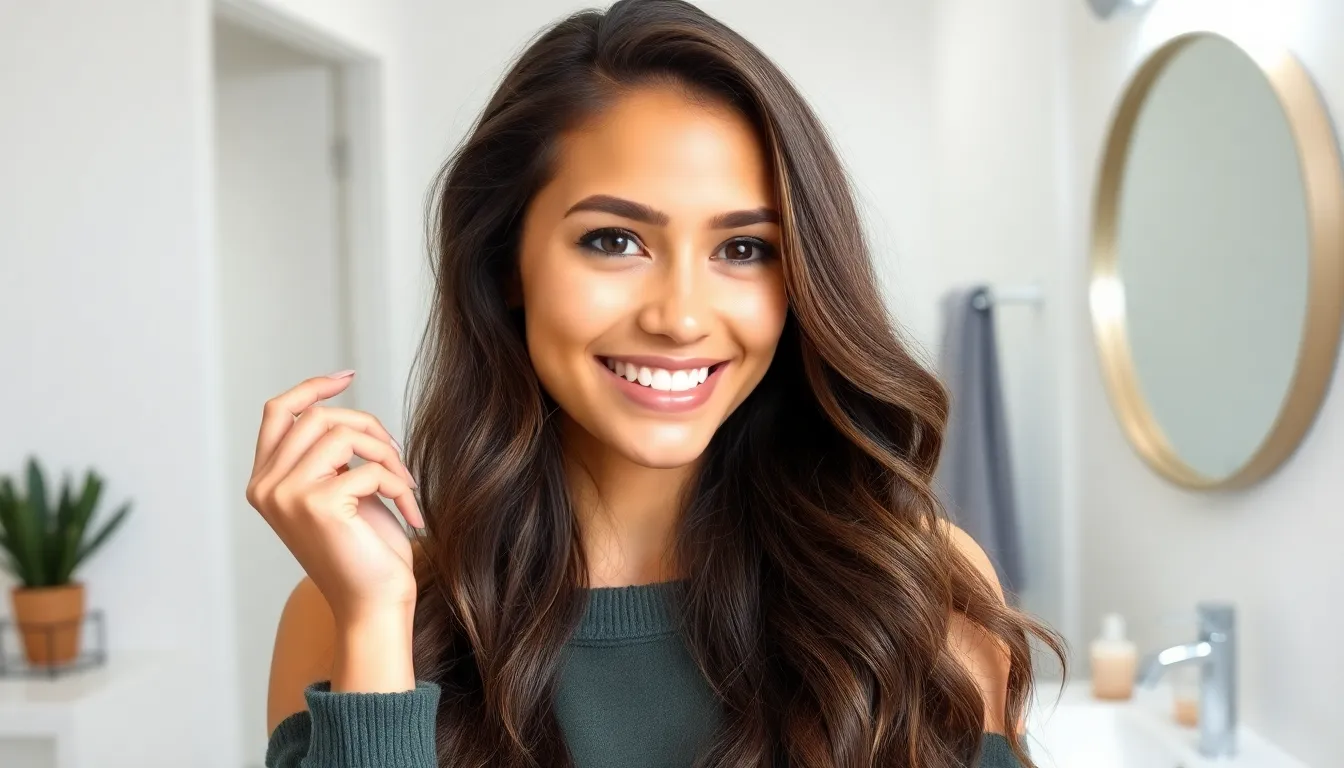
Flow hairstyles require consistent care to maintain their signature movement and texture. We’ll explore the essential maintenance practices that keep your flow looking fresh and healthy.
Daily Maintenance Routines
Start your morning with gentle finger combing to preserve natural texture without creating static. We recommend using a wide tooth comb only on damp hair to prevent breakage and frizz. Apply a lightweight leave in conditioner to damp strands, focusing on mid lengths and ends where flow hairstyles need the most moisture.
Avoid aggressive towel drying that can disrupt your hair’s natural movement patterns. Instead, we suggest gently squeezing excess water with a microfiber towel or cotton t-shirt. Use sea salt spray on towel dried hair to enhance natural waves and add the effortless texture that defines flow styles.
Sleep protection prevents morning styling disasters and maintains your flow’s shape overnight. We recommend using a silk pillowcase or loose hair tie to keep longer sections from tangling. Refresh your style each morning with a light misting of water and a small amount of texturizing cream worked through with your fingers.
Weekly Deep Care Treatments
Deep conditioning treatments restore moisture that daily styling and environmental exposure can strip away. We suggest using a protein free mask once weekly, leaving it on for 10 to 15 minutes before rinsing thoroughly. Focus the treatment on the mid shaft to ends where flow hairstyles experience the most wear.
Scalp exfoliation removes product buildup that can weigh down your flow’s natural movement. We recommend using a gentle scrub or clarifying shampoo every 7 to 10 days to maintain healthy hair growth. Massage the treatment into your scalp for 2 minutes before rinsing completely with cool water.
Oil treatments add shine and control frizz without compromising your flow’s natural texture. We prefer lightweight options like argan oil or jojoba oil applied to damp hair before styling. Use only 2 to 3 drops distributed through your palms and worked into the ends to avoid weighing down the roots.
When to Schedule Trims
Schedule maintenance trims every 6 to 8 weeks to prevent split ends from traveling up the hair shaft and destroying your flow’s smooth movement. We recommend booking appointments before you notice important length changes, as flow hairstyles depend on precise layering for their signature look.
Watch for these signs that indicate trim time: ends that stick out awkwardly, loss of natural movement, or difficulty achieving your usual styling results. We suggest taking photos of your flow from different angles to track changes and share them with your stylist for consistent results.
Communicate your flow goals clearly during each appointment to maintain the style’s integrity over time. We recommend bringing reference photos and discussing how much length to maintain while refreshing the layers. Ask your stylist to trim conservatively, removing only what’s necessary to restore shape and movement.
Celebrity Inspiration: Famous Flow Hairstyles to Copy

Hollywood stars and professional athletes have transformed flow hairstyles into iconic looks that dominate red carpets and sports arenas worldwide. We’ve identified the most influential celebrity flow styles that offer versatile inspiration for anyone looking to embrace this effortless aesthetic.
Leonardo DiCaprio’s Classic Beach Flow represents the gold standard of surfer-inspired styling that works across multiple decades. His naturally tousled approach showcases how medium-length layers can create movement without excessive product manipulation. We observe how his styling technique emphasizes air-drying methods that preserve natural texture while maintaining sophisticated appeal for formal events.
Brad Pitt’s Textured Pompadour Flow demonstrates how traditional flow cuts adapt to contemporary grooming trends through strategic layering. His variation incorporates subtle volume at the crown that transitions smoothly into longer side sections. Celebrity stylists report that this particular approach requires minimal daily maintenance while delivering maximum visual impact across different lighting conditions.
Timothée Chalamet’s Romantic Flow showcases how younger celebrities embrace longer flow variations that challenge conventional masculine grooming boundaries. His styling approach celebrates natural curl patterns while maintaining controlled movement through strategic cutting techniques. Fashion photographers consistently highlight how this style photographs exceptionally well from multiple angles during high-profile appearances.
Jason Momoa’s Warrior Flow illustrates how flow hairstyles translate across different hair textures and cultural backgrounds through personalized adaptation. His approach combines traditional flow principles with cultural significance that resonates with diverse audiences. We notice how his styling choices emphasize natural oils and minimal product intervention that supports healthy hair growth patterns.
Ryan Gosling’s Vintage Flow Revival brings retro flow aesthetics into contemporary settings through carefully curated styling choices. His interpretation balances classic Hollywood glamour with modern practicality that appeals to professional environments. Celebrity barbers note that this style works particularly well for straight to slightly wavy hair textures that hold shape throughout extended wear periods.
Harry Styles’s Gender Fluid Flow represents how flow hairstyles transcend traditional styling boundaries while maintaining universal appeal. His approach demonstrates versatility through various length adjustments and styling products that accommodate different performance requirements. Music industry professionals observe how his flow variations influence broader cultural conversations about modern masculinity and self-expression.
Flow Hairstyles for Different Occasions

Flow hairstyles adapt seamlessly to various settings and events, making them versatile choices for modern grooming needs. We’ll explore how to style your flow cut for different occasions while maintaining that effortless, natural movement.
Casual Everyday Flow Looks
Effortless Bedhead Flow creates the perfect relaxed vibe for weekend activities and casual outings. We achieve this look by scrunching damp hair with sea salt spray and air drying for natural texture. The result appears completely unstudied while highlighting your hair’s natural movement patterns.
Tousled Side Sweep Flow works exceptionally well for coffee dates, shopping trips, and casual social gatherings. Start with texturizing cream on towel dried hair, then use your fingers to push longer sections to one side. This style requires minimal maintenance throughout the day yet looks intentionally styled.
Messy Top Flow delivers maximum casual appeal for gym sessions, outdoor adventures, and relaxed hangouts. Apply lightweight mousse to damp hair and scrunch sections while blow drying on low heat. The finished look appears naturally disheveled while maintaining controlled volume and movement.
Professional Flow Styles for Work
Polished Back Flow transforms your casual flow into workplace appropriate styling with sophisticated appeal. We recommend using a lightweight pomade to smooth longer sections backward while maintaining subtle texture. This style works perfectly for client meetings, presentations, and corporate environments.
Controlled Side Part Flow offers professional polish without sacrificing the flow aesthetic’s natural charm. Create a defined side part using a fine tooth comb, then apply styling cream to tame flyaways while preserving movement. The result appears refined yet modern for business casual settings.
Sleek Forward Flow provides contemporary professional styling that’s ideal for creative industries and modern workplaces. Apply anti frizz serum to damp hair, then blow dry forward using a paddle brush for smoothness. This approach maintains flow characteristics while appearing polished and intentional.
Special Event Flow Hairstyles
Formal Swept Flow elevates your natural texture for weddings, galas, and black tie events. We achieve this sophisticated look by applying strong hold gel to damp hair and combing everything backward smoothly. The style maintains flow movement while appearing appropriately formal for upscale occasions.
Textured Celebration Flow works beautifully for parties, date nights, and social celebrations where you want maximum style impact. Use volumizing mousse at the roots and texturizing spray throughout the lengths for enhanced body and definition. This creates dramatic movement that photographs well under event lighting.
Red Carpet Flow delivers magazine worthy styling for premieres, award shows, and high profile events. Professional stylists often use heat protectant spray followed by strategic blow drying with a round brush to create controlled waves. The finished result appears effortlessly glamorous while maintaining the signature flow aesthetic that celebrities favor.
Common Flow Hairstyle Problems and How to Fix Them
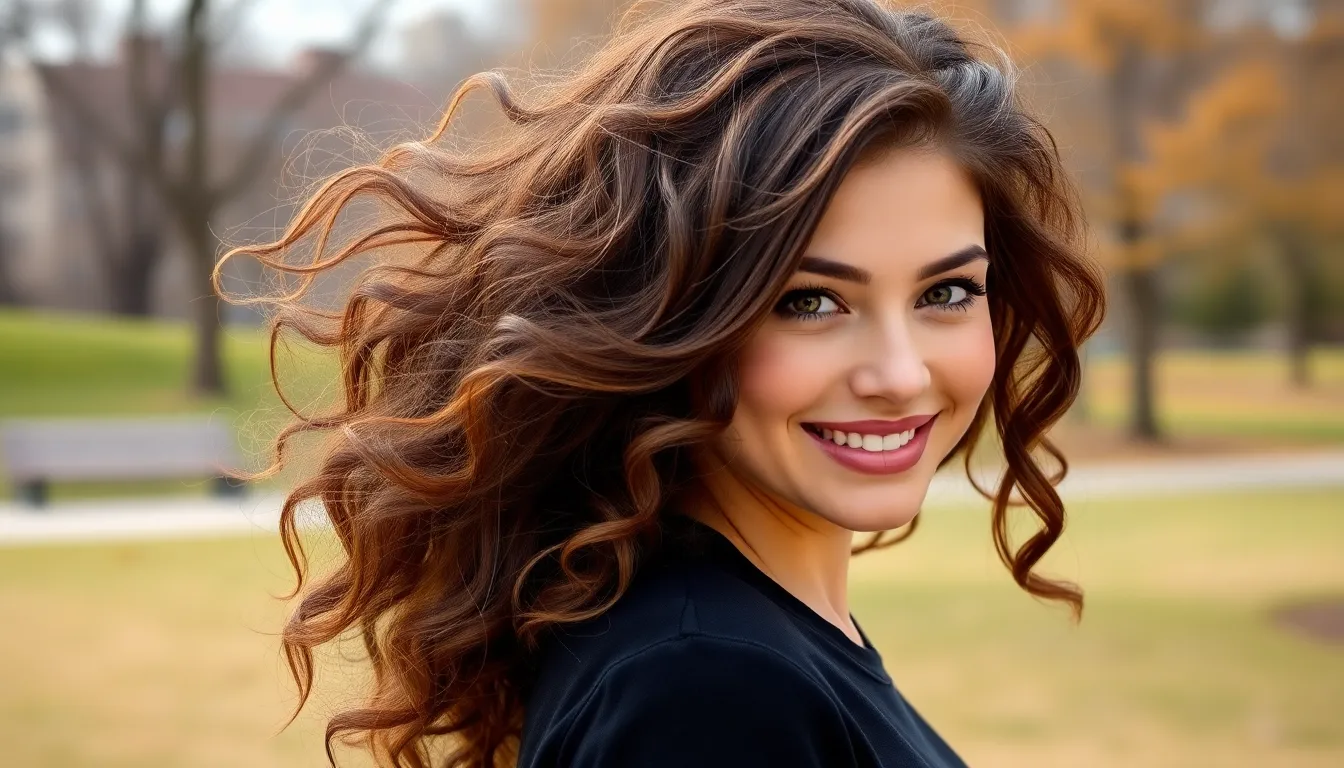
Flow hairstyles can present unique challenges that we’ll help you overcome with proven answers. Most issues stem from improper cutting techniques or inadequate maintenance routines that disrupt the natural movement these styles require.
Flat, Lifeless Hair Without Volume
Flat hair kills the ever-changing movement that makes flow styles so appealing. We recommend starting with a volumizing shampoo and applying it only to your scalp area. Blow dry your hair upside down using a round brush to create lift at the roots. Sea salt spray works wonders when applied to damp hair before styling. Avoid heavy products that weigh down your strands and opt for lightweight mousses instead.
Uneven Length Distribution
Uneven lengths create an awkward, choppy appearance rather than the smooth flow you want. Visit a skilled barber who understands layered cutting techniques every 6 to 8 weeks. Between appointments, resist the urge to trim sections yourself. Professional stylists use point cutting and slide cutting methods to maintain proper length graduation. Document your preferred style with photos to ensure consistent results across different appointments.
Excessive Greasiness at the Roots
Greasy roots make flow hairstyles look unkempt and destroy their natural texture. Wash your hair every other day using a clarifying shampoo to remove product buildup. Apply conditioner only to the mid lengths and ends, avoiding the scalp entirely. Dry shampoo becomes your best friend for refreshing your style between washes. Choose sulfate free products that won’t strip your hair’s natural oils completely.
Frizz and Uncontrolled Texture
Frizz transforms your smooth flow into an unmanageable mess that defies styling efforts. Use a microfiber towel or cotton t-shirt to dry your hair instead of regular terry cloth towels. Apply a leave-in conditioner with anti-frizz properties while your hair is still damp. Sleep on silk or satin pillowcases to reduce friction that causes overnight frizz. Humidity protection sprays create a barrier against environmental factors that trigger frizzy hair.
Difficulty Maintaining Shape Throughout the Day
Flow hairstyles that lose their shape quickly indicate improper styling foundation or wrong product selection. Start with clean, slightly damp hair for better product adherence and longer lasting results. Use a combination of texturizing spray and light hold cream rather than relying on one product alone. Finger comb your hair periodically throughout the day to refresh the natural movement. Avoid touching your hair excessively, as oils from your hands can disrupt the style.
Split Ends and Damaged Hair
Damaged hair prevents flow styles from achieving their characteristic smooth, healthy appearance. Schedule regular trims to remove split ends before they travel up the hair shaft. Deep condition your hair weekly using protein rich treatments to strengthen damaged strands. Limit heat styling to twice per week maximum, always using a heat protectant spray beforehand. Protect your hair from UV damage with specialized hair sunscreens during outdoor activities.
Conclusion
Flow hairstyles have proven their staying power in men’s grooming by offering the perfect balance of style and practicality. We’ve seen how these versatile cuts adapt to any hair type face shape or lifestyle while maintaining their signature effortless appeal.
The beauty of flow hairstyles lies in their ability to grow with you literally and figuratively. Whether you’re drawn to classic variations or modern interpretations these cuts offer endless possibilities for personal expression without demanding hours of daily maintenance.
As we move forward flow hairstyles will continue evolving while maintaining their core appeal. They represent more than just a trend – they’re a grooming philosophy that celebrates natural movement authenticity and individual style. For men seeking a hairstyle that works as hard as they do flow cuts remain an unbeatable choice.
Frequently Asked Questions
What exactly is a flow hairstyle?
A flow hairstyle is a distinctive grooming approach that emphasizes natural movement and texture through strategically layered cuts. It typically features longer lengths on top (4-8 inches) that blend into shorter sides, creating a flowing, effortless appearance. The key characteristics include layered texturing for depth and versatile styling options that work across different hair types and face shapes.
Why have flow hairstyles become so popular recently?
Flow hairstyles have gained significant traction due to several factors, including a 40% increase in requests since 2022. The trend’s popularity stems from remote work flexibility, athletic influences, celebrity endorsements, and the embrace of gender-fluid fashion. Social media visibility and the style’s low-maintenance nature have also contributed to its widespread appeal among modern men.
Can flow hairstyles work with different hair types?
Yes, flow hairstyles are highly adaptable to various hair textures. Straight hair works well with Classic Side Swept Flow and Pompadour Flow. Wavy hair benefits from Beach Wave Flow and Tousled Flow styles. Curly hair can embrace Defined Curl Flow and Loose Curl Flow. Stylists customize cuts to complement individual hair characteristics for optimal results.
What tools do I need to achieve a flow hairstyle at home?
Essential tools include quality hair clippers with various guards, texturizing shears, a fine-tooth comb, and a blow dryer. Key products needed are sea salt spray for texture, lightweight styling cream for hold, and leave-in conditioner for moisture. These basics allow you to create and maintain the flowing movement characteristic of this style.
How do I choose the right flow hairstyle for my face shape?
Face shape significantly impacts flow hairstyle selection. Round faces benefit from angular styles like Pompadour Flow to elongate appearance. Square faces suit softer styles like Surfer Flow to counterbalance sharp features. Oval faces have the most versatility and can wear Traditional Hockey Flow or Rockstar Flow effectively, as they complement balanced facial proportions.
How often should I maintain my flow hairstyle?
Regular maintenance is crucial for optimal results. Schedule professional trims every 6-8 weeks to prevent split ends and maintain the style’s integrity. Daily care involves gentle finger combing and using lightweight leave-in conditioners. Weekly deep conditioning treatments and scalp exfoliation help maintain moisture and promote healthy hair growth while preserving the natural flowing movement.
What are common problems with flow hairstyles and their solutions?
Common issues include flat hair (use volumizing products), uneven length distribution (visit skilled barbers), excessive greasiness (use clarifying shampoos), and frizz (apply anti-frizz treatments). Difficulty maintaining shape can be resolved with proper styling techniques, while split ends require regular trims. Consistent maintenance routines help preserve the hairstyle’s natural movement and health.
Can flow hairstyles work for professional settings?
Absolutely. Flow hairstyles bridge casual and formal styling needs effectively, making them suitable for various settings and events. Their versatility allows for professional presentation while maintaining the effortless, modern aesthetic. The key is proper styling and maintenance to ensure a polished appearance that meets workplace grooming standards while showcasing personal style.

